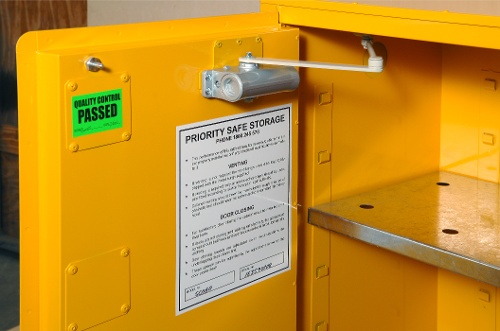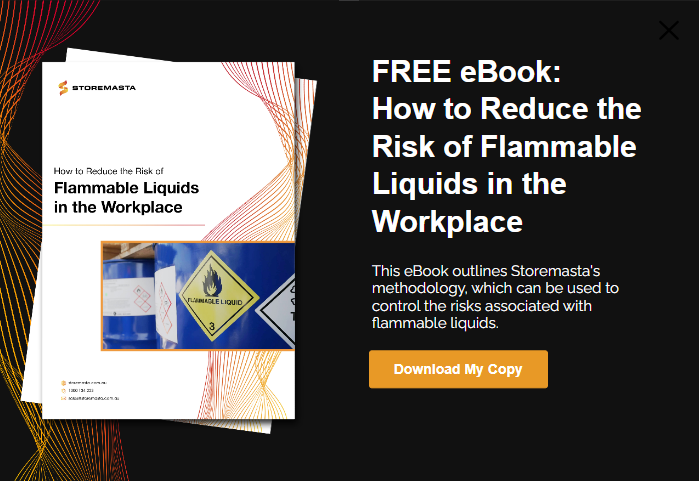Flammable liquids are extremely volatile substances, and failure to store them in a compliant flammable cabinet can result in severe harm to the people, property and environment of your organisation. These flammable substances are found in workplaces across a broad range of industries, with popular products such as petrol, paints, thinners and acetone all being recognised as Class 3 Flammable Liquids.
However, just because flammable liquids are a common sight at workplaces across the country, doesn’t mean that they shouldn’t be treated as a dangerous good. Flammable liquids must be stored in a compliant manner and require the utmost care when being handled and used.
Why is Compliant Flammable Storage Important?
AS 1940 is the Australian Standard that outlines the requirements for the storage and handling of flammable and combustible liquids. Only a flammable cabinet that has been manufactured in full conformance to the design requirements of AS 1940 can be used for the storage of flammable liquids.
And while selecting a flammable liquids storage cabinet is the first step in meeting your legal obligations, you must also keep in mind that your cabinet needs to be positioned and maintained in the correct way. Failure to do so means your organisation won’t be able to achieve full compliance.
Failure to comply with the legal WHS regulations may result in:
- Hazards to your people, property and environment
- On the spot fines for work health and safety breaches
- Being charged with an offence; the category of which depends on the seriousness of the breach or the liability involved
Compliant storage for flammable liquids is not a recommendation – it’s a legal requirement in Australia. So regardless of whether you’re storing a small amount of flammable liquid in your workshop, or you have multiple types of flammable liquids in large quantities at your factory, there are several steps you can take to make sure that your workplace is meeting your compliance requirements.
Requirements for Flammable Cabinet Storage
As flammable liquids pose risks to workplaces and their personnel, it’s crucial that you use your flammable storage cabinet in full conformance to AS 1940.
The requirements for flammable liquids cabinets include:
- Positioning your cabinet in a safe location
- Storing no more than 850L per 250 m2 of floor space
- Isolating the flammable liquids from ignition sources
- Only storing compatible substances within the cabinet
- Marking the cabinet with the correct dangerous goods signage
Where Should You Install Larger Flammable Cabinet?
To ensure that the flammable liquids in your workplace pose the minimum level of risk upon the people and property of your workplace, flammable storage cabinets must be position in a strategic manner.
The positioning requirements according to AS 1940 are outlined below:
- Flammable storage cabinets that have a capacity greater than 250L must not be placed nearer than 3 metres to any wall that is common with another room. There is an exception to this requirement if the wall is constructed of concrete or masonry and it extends 3m above the top of the flammable cabinet and 3 metres either side.
- Cabinets that have a capacity greater than 250L shouldn’t be placed on any floor other than those that have direct access to the street or ground level.
- Flammable cabinets that have a capacity greater than 250L should only be installed in factories and workshops. They must not be installed in:
- Residential accommodation buildings
- Hospitals
- Aged care buildings
- Schools
- Commercial buildings
- Locations that may impede the escape of personnel in the event of an emergency
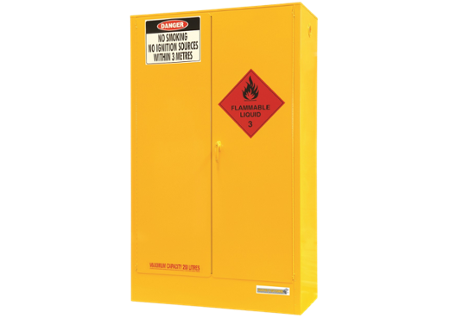
Storemasta's indoor Class 3 Flammable Liquid Cabinet
Maximum Storage Capacity
Storing flammable liquids indoors poses many risks upon the people and property of your organisation. To minimise this risk, AS1940 has set certain limits on the maximum quantities of flammable liquids that can be stored indoors.
According to the Australian Standards, the aggregate capacity of cabinets that can be used indoors are:
- 850L per 250m2 of floor space on ground floors
- 250L per 250m2 of floor space on floors other than ground floors
In all cases, each aggregate quantity of flammable liquids, (850L on ground floors and 250L on other floors), must be segregated by at least 10m.
Flammable Cabinet Signage
All flammable storage cabinets must be marked with the relevant dangerous goods signage. This is to ensure that all visitors and workers in your organisation are aware of the potential hazards associated with flammable liquids.
Your dangerous goods signage must also be clearly visible, even when the doors of the flammable storage cabinet are closed.
The required dangerous goods signage of flammable storage cabinets include:
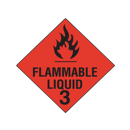
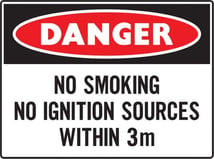
No Smoking No Ignition Source Within 3m
To ensure that cabinet maintenance requirements are attended to in a swift manner, the cabinet manufacturers name, phone number and address must be clearly marked on the cabinet.
Exclusion of Ignition Sources
Flammable liquids are extremely volatile substances. At temperatures below 60 °C, flammable liquids will give off enough flammable vapours to ignite in the presence of an ignition source.

Ignition sources can include tools and equipment that produce heat, flames or sparks.
To avoid the risk of fires, ignition sources must never be placed within flammable storage cabinets. Flammable liquids storage cabinets must also be positioned in a location that is at least 3 metres from any ignition source measured horizontally. Ignition sources must also be excluded from the cabinet by 1 metre above any opening on the cabinet.
Incompatible Chemicals
Class 3 Flammable Liquids are incompatible with most classes of dangerous goods. If incompatible substances mix, it can result in violent chemical reactions that could harm the people and property of your organisation.
To reduce the risk of workplace incidents, incompatible substances must not be stored inside flammable storage cabinets or other types of chemical stores.
Flammable storage cabinets are also a safe and efficient way to segregate flammable liquids from incompatible classes of dangerous goods.
If incompatible classes of dangerous goods are not stored in separate safety cabinets, they must be separated by specific distances as outlined the Australian Standards AS 3833. The required distance of separation is normally 3 to 5 metres, which can be hard to achieve in confined spaces.
Flammable Cabinet Staff Training
To comply with the WHS Regulations, we suggest a series of training sessions instructing workers, supervisors and contractors how to use the flammable cabinet.
Your training session could be conducted in small groups, where the workers physically inspect the cabinets — familiarising themselves with all the safety features. You could also use video training sessions to educate your staff base.
Videos can also be an effective training method that reaches multiple teams or a variety of business locations simultaneously. There is also the added advantage of staff being able to reference the video training session anytime they need a refresher course.
You should start your training session by allowing your workers to become familiar with the physical construction of the flammable liquids storage cabinet. By understanding how the cabinet is designed and constructed to minimise chemical risks, you’ll be able to educate your team on the correct way to use the cabinet.
Your session would include the following:
Cabinet Doors
Demonstrating how to open and close the doors of the cabinet without damaging the doors and self-closing mechanisms.
POINTERS:
- Don’t prop open the doors while loading and unloading the cabinet.
- Make sure the handle closes properly and the doors align once they are closed.
Storemasta indoor chemical cabinet doors offer extra protection through the patented automatic door closing system, which closes softly and in sequence.
Spill Sump
Explaining the capacity of the spill sump and how to inspect it for leaks and spills
POINTERS:
- Clean up spills immediately.
- Don’t put away containers without the cap or lid firmly in place.
- Make sure nothing is kept in the lower spill compound.
- Clean the exterior surface of all containers prior to placing them in cabinet.
Capacity and Loading
Showing staff the official capacity label on the cabinet, explaining approved capacity rating and how overloading can impact safety.
POINTERS:
- Don’t load the cabinet past its approved capacity.
- Pack containers and drums away properly and ensure nothing will catch in the doors.
- Demonstrate the largest container/drum that can be used in the cabinet.
- Never allow a worker inside the cabinet.
Segregation
Teaching staff about incompatibility hazards, as well as the consequences associated with mixing classes of dangerous goods
POINTERS:
- Only store Class 3 Flammable Liquids in the cabinet.
- Do not bring other chemicals close to the Class 3 cabinet when it is being opened as this may cause incompatibility hazards.
- Always check the labels of your dangerous goods before placing them back in the cabinet to ensure they are the correct product for that cabinet.
- Ensure the correct chemical segregation distances are applied within your workplace.
Fire Control
Explaining the requirements in relation to the isolation of all ignition sources in or near the cabinet. Teaching staff about the thermal air barrier (which allows a 10 minute window of time in the event of a fire) and how it assists with fire evacuations and the activation of fire fighting systems.
POINTERS:
- Remove excess packaging and cartons before putting chemical containers in storage.
- Do not allow any type of ignition source within 3 metres of the cabinet.
- Ensure that all No Ignition Source signage is always in place and in good condition.
IMPORTANT: To learn more about flammable liquid cabinet inspections and maintenance, read our popular post, Developing an Inspection Checklist for your Flammable Liquids Cabinet.
Is Your Cabinet Compliant?
In this blog, we’ve highlighted the right way to use your flammable cabinet, so your workplace can achieve full compliance and meet your legal obligations. Remember, that failure to meet to these legal requirements could result in workplace incidents involving harm to workers and loss of property.
If you’d like to find out more about flammable liquids storage and how you can meet your compliance requirements, we have a FREE eBook that can help. How To Reduce The Risk Of Flammable Liquids In The Workplace is a helpful resource that allows you to effectively reduce the risks associated with the use of flammable liquids. It also contains our proven 4-step risk management methodology: Identify – Assess – Control – Sustain, which provides a clear guide on achieving compliance for your workplace.

Living life by the 4 C’s of marketing – communication, coffee, compliance… and more coffee – Leisa Andersen is Storemasta’s Content Marketing Manager. When she’s not writing, you’ll find her enjoying all the good things in life, including shopping, travel and gluten free donuts.

